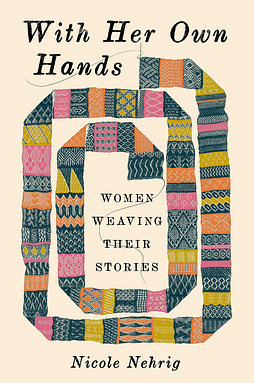With Her Own Hands: Women Weaving Their Stories Though fiber arts such as knitting, weaving, and spinning have often been dismissed as "merely women's work", such arts have been vital to the survival of humanity and have served as outlets of expression, communication, and power for women throughout history and around the world. In With Her Own Hands: Women Weaving Their Stories, psychologist and avid knitter Nicole Nehrig explores the richness of fiber arts and the communities women everywhere have built around them. Nehrig talks to Black quilters in Mississippi who have used their artistry to rise out of poverty, Quechua weavers in Peru who are reviving Incan traditions, and other women around the world who have used their skills in the fiber arts to heal from trauma or communicate across time and distance. Whether someone knits as a hobby or sews professionally, fiber arts have a profound effect on humanity– especially for women, whose lives have been wrapped around these arts for thousands of years. I learned to crochet over twenty years ago, but it's only been in the past few years that I've really taken an interest in fiber arts. I got into hand sewing during the initial COVID outbreak in 2020, and have taken up knitting in the past few months. I occasionally feel the siren song of spinning, but I have decided that three fiber arts is enough for now- especially since I am only at the beginner stage for all of them. Yes, that includes crochet, as despite my twenty years of working at it, I've never bothered to go further into it. I've been happy with what I've made with the skills I have. Regardless of my skill at actually making things with yarn or cloth, I enjoy reading about textiles and fiber arts so requesting With Her Own Hands was an obvious choice. Nicole Nehrig took up knitting in her twenties, when her life was unraveling around her and the future she thought she'd been building suddenly disappeared. When she started attending graduate school for psychology and began building a new career, she started knitting more than ever. The repetitive nature of the craft, the tangible progress, and the ability to fix mistakes provided a counter to her work as a therapist and allowed her to connect with other knitters in her community. When the pandemic struck in 2020, Nehrig's life– like many others– was put on hold again, with new stressors affecting her and her family. One of the results of this restructuring of Nehrig's life was to once again upend her career plans. She found she was no longer interested in the clinical side of psychology. Instead, she grew more interested in investigating fiber arts such as knitting and weaving to see how women have used them to deal with the stress of everyday life, overcome obstacles, and create meaning in their lives. The result of that research is this book, and while Nehrig does not take a deep dive into any one of the topics or communities she writes about, she nevertheless gives the reader a solid takeaway: fiber arts have always given women an outlet for expression and opportunities to build wealth, even when society hasn't always valued their work. It's a strange thing to see in fantasy stories aimed at girls: the plucky heroine rejects the idea that she has to stay home and sew when she would rather pick up a sword and fight bad guys because that shows real strength. And yet the work that women do has always been vital to survival. Without fiber arts, we wouldn't have clothes to protect us from the elements, bags to put our things in, or threads to stitch up wounds. There would have been no sails for the boats at sea or fabric for the tents that gave shelter to travelers the world over. But while many societies have denigrated fiber arts, women have kept spinning, weaving, and sewing to create beautiful and useful things. It was fascinating to see, too, how women have used fiber arts to communicate with each other and heal. Nehrig highlights sewing groups where women who have faced horrific trauma have been able to begin healing by sewing their stories and turning them into something tangible they can share. Healing through craft isn't just for wired professionals who knit on the weekends. Though it's a bit surface level, With Her Own Hands provides a fascinating look at the importance of fiber arts for the ones who make them, and for society as a whole. Traveling in Books is free today. But if you enjoyed this post, you can tell Traveling in Books that their writing is valuable by pledging a future subscription. You won't be charged unless they enable payments. |
Tuesday, 29 July 2025
Book Review: With Her Own Hands
Subscribe to:
Post Comments (Atom)
Making Sense of the Voices in Your Head
With Internal Family Systems ͏ ͏ ͏ ͏ ͏ ͏ ͏ ͏ ͏ ͏ ͏ ͏ ͏ ͏ ͏ ͏ ...
-
https://advanceinstitute.com.au/2024/04/24/sunnycare-aged-care-week-10/?page_id=...
-
barbaraturneywielandpoetess posted: " life on a rooftop can be short ; depends whether one looks down or up . ...

No comments:
Post a Comment